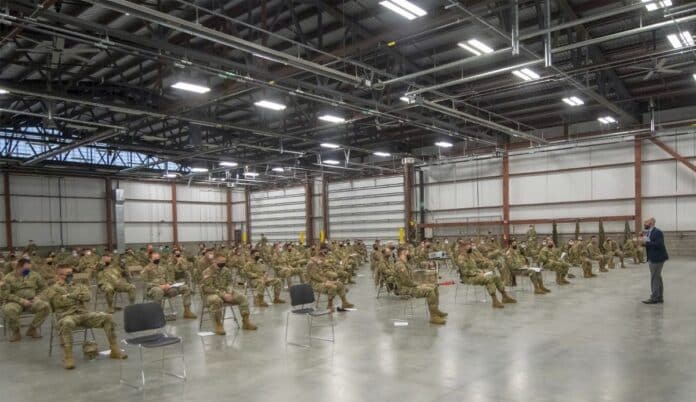
CAMP ATTERBURY — About 400 soldiers from the Indiana National Guard gathered Friday at Camp Atterbury, training for a unique mission.
They were getting ready to help some of Indiana’s most vulnerable residents fight COVID-19. The soldiers were learning how to put on personal protective equipment, how to do wellness checks and what a day at a long-term care facility is like.
By Monday, the group will disperse among nursing homes, senior living facilities and other long-term care units throughout the state. The soldiers are scheduled to be placed in 133 of the hardest hit long-term care facilities, said Brig. Gen. Dale Lyles, adjutant general of the Indiana National Guard.
The state is targeting facilities with higher numbers of cases among residents and staff, and facilities where help has been requested, State Health Commissioner Kristina Box said earlier this week. Two new outbreaks have surfaced in Johnson County, at Franklin and Greenwood facilities. A COVID-19 outbreak began last week at Franklin Meadows and escalated quickly to 33 cases, according to data from the facility’s parent company American Senior Communities. Cases at Greenwood Village South began to pick up around Oct. 7, when 10 residents and five staff members tested positive, according to data from that facility. By mid-week, there had been 85 cases among residents and 44 among staff members, data shows.
[sc:text-divider text-divider-title=”Story continues below gallery” ]Click here to purchase photos from this gallery
“For us, it means helping the community and gaining experience in future careers,” said Andrea Spiegler, a four-year veteran of the National Guard. “I’ve learned a lot more about the community because we’ve been all throughout Indiana. So I was able to reassess and then help my community better.”
The Indiana National Guard has been assigned to assist long-term care facilities throughout Indiana in handling the ongoing coronavirus pandemic. By mid-November, they will be in every long-term care facility in the state to assist with testing, report test results, screen employees and ensure infection control practices are in place.
The National Guard’s mission is to mitigate the destruction of the disease and support overwhelmed staff members.
“We recognize this is a non-standard mission, or a non-standard set of tasks for these soldiers. They don’t usually do these things, and it’s not really what they were trained to do in the military. But at the end of the day, they’re citizen-soldiers, and they understand that helping to augment the staff is really what this is about,” Lyles said.
Gov. Eric Holcomb ordered the National Guard deployment to long-term care facilities as COVID-19 cases have steadily increased in recent weeks. Holcomb’s office worked with Dr. Kristina Box, state health commissioner, as well as Indiana National Guard leadership to put together a plan over the past three weeks, Lyles said.
Residents of these facilities have been significantly impacted by the pandemic, as they are at higher risk for severe complications. About 58% of the COVID-19 deaths reported in the state have occurred among residents of these facilities, according to the Indiana State Department of Health.
“The staff at long-term care facilities have been working tirelessly to protect the residents in their care, but even the most dedicated teams need extra hands and support,” Box said. “We hope that sending additional resources to help with infection control and screening will allow these staff to keep their focus on patient care.”
Over the course of three days, National Guard soldiers trained for the mission and learned about the conditions they would face during this unique situation. All soldiers receive basic medical training as part of their preparation in the National Guard, but for this mission, they also learned how to properly wear their protective gear, what they can expect from staff and residents of these facilities, and how to protect themselves and those they’re helping.
“It’s an honor and a privilege to be able to do this,” said Sgt. Tommy Brock, a soldier from Indianapolis. “Anything I can do to give back to the community, I want to do.”
Brock has been in the Indiana National Guard for four years as a military police officer. Preparing for this mission has been different than anything he has done as a soldier in the past, but he picked up the training quickly.
“We’re trying to get informed on everything we’ll be heading into,” he said.
The soldiers were trained by professional staff from Probari, a company working with the state health department to teach front-line workers infection control measures to reduce unnecessary transfers of COVID-19 positive individuals to hospitals.
With the training she’s been given, and experience she’s gathered throughout the pandemic, Spiegler felt prepared and comfortable heading into this mission.
“We’ve actually been quite squared away. The Indiana National Guard has really taken care of not only the soldiers, but also the community as well,” she said.
In the next three weeks, additional soldiers will be trained and assigned to all 534 facilities in Indiana. The plan is to have a total of 1,350 soldiers serving throughout the state until Dec. 31, Lyles said.
“Then we’ll gauge where we are at that time and determine if we need to extend past that,” he said.
Prior to placement in the facilities, all of the soldiers will receive a COVID-19 test, and during their assignment, they will be tested and monitored regularly, Lyles said. The state health department will provide them with scrubs and personal protective equipment, including masks, gloves, goggles and gowns.
“My biggest concern is that we make a difference,” Lyles said. “We’re going to be putting some metrics together, some measure of performance to see where we are making a difference, then assessing those metrics and determining where we can put resources to continue to stop the spread of this virus.”




